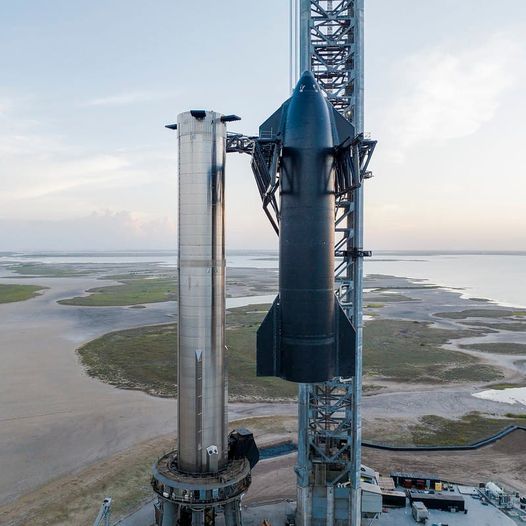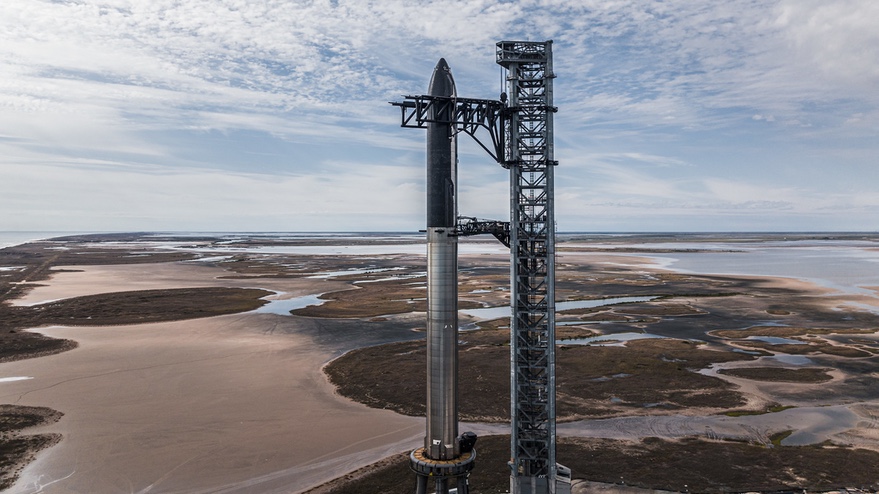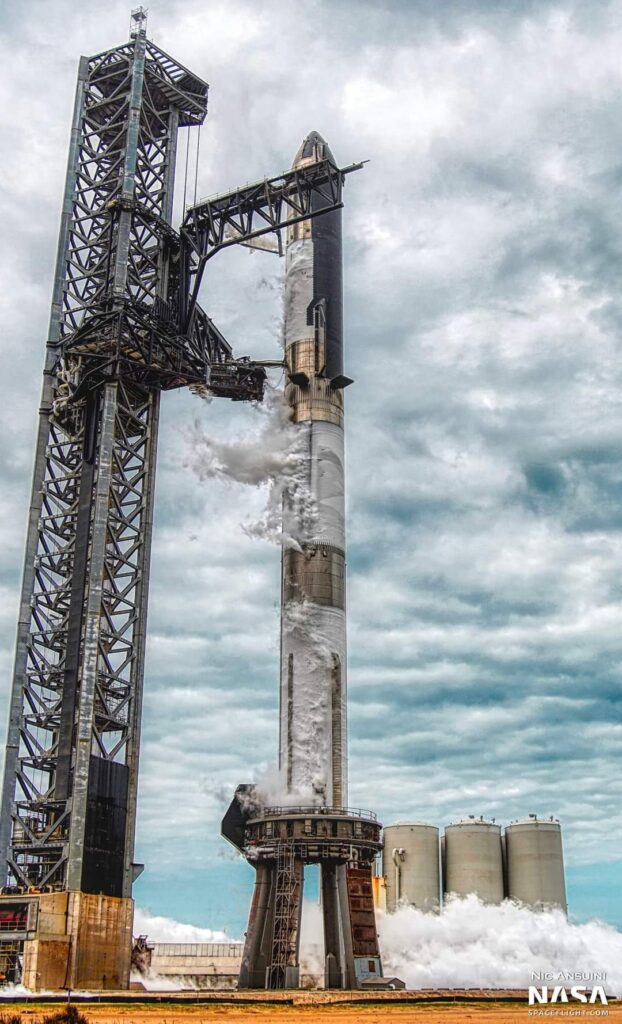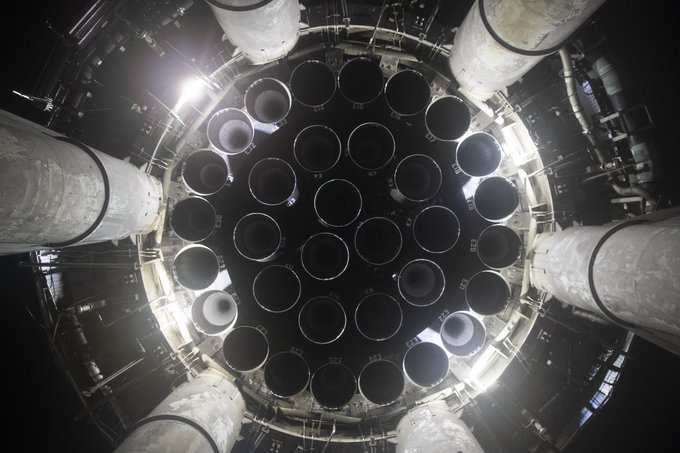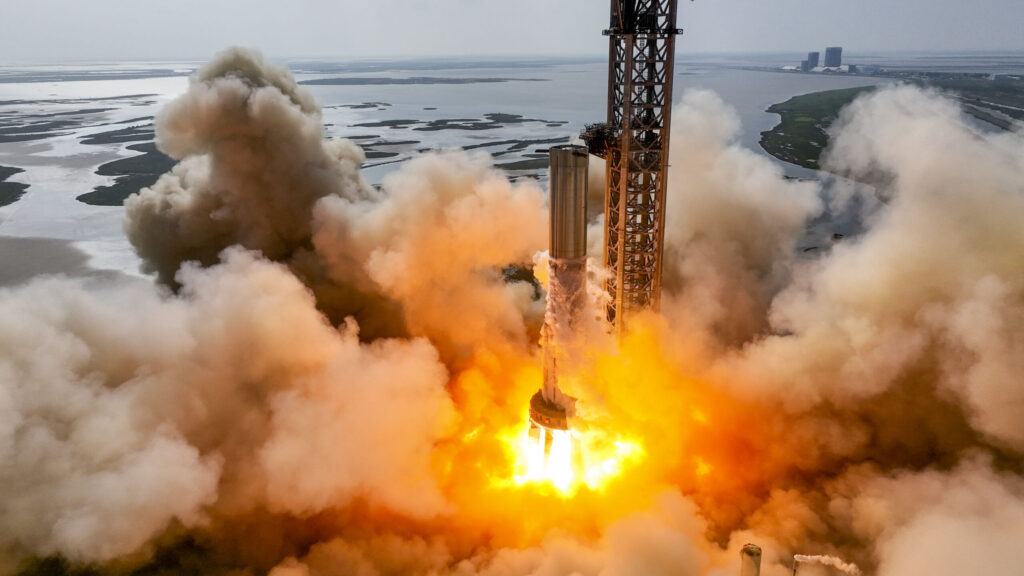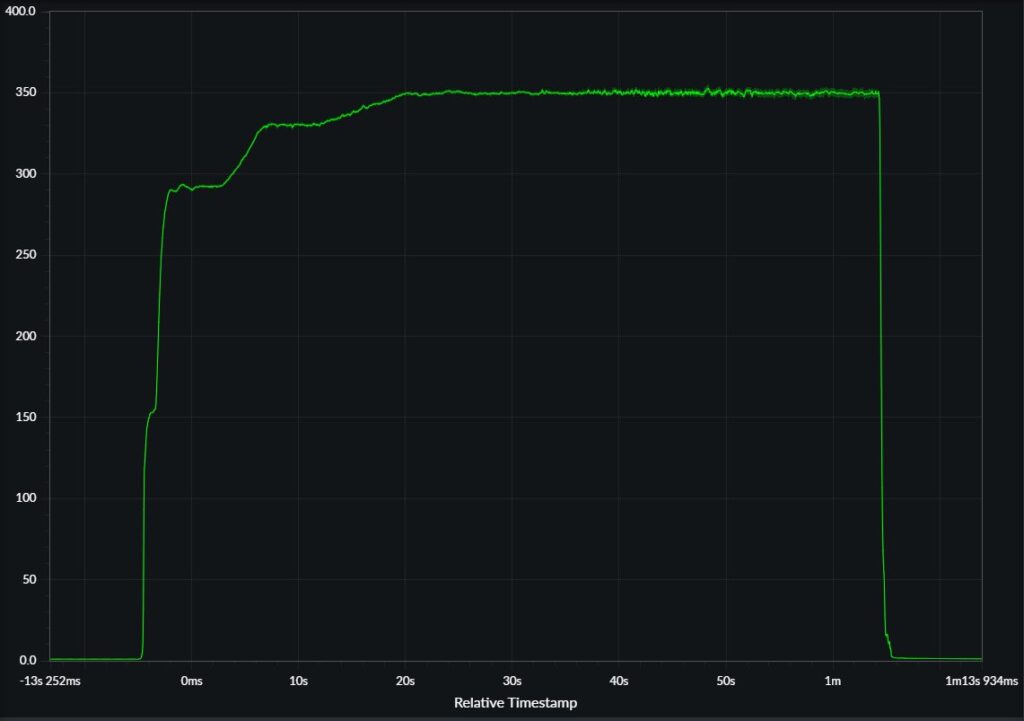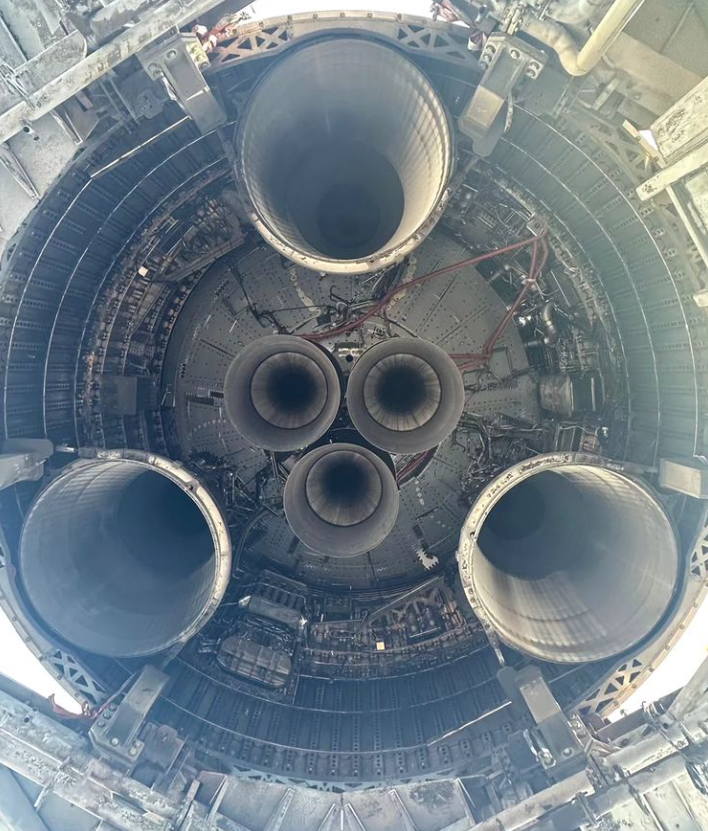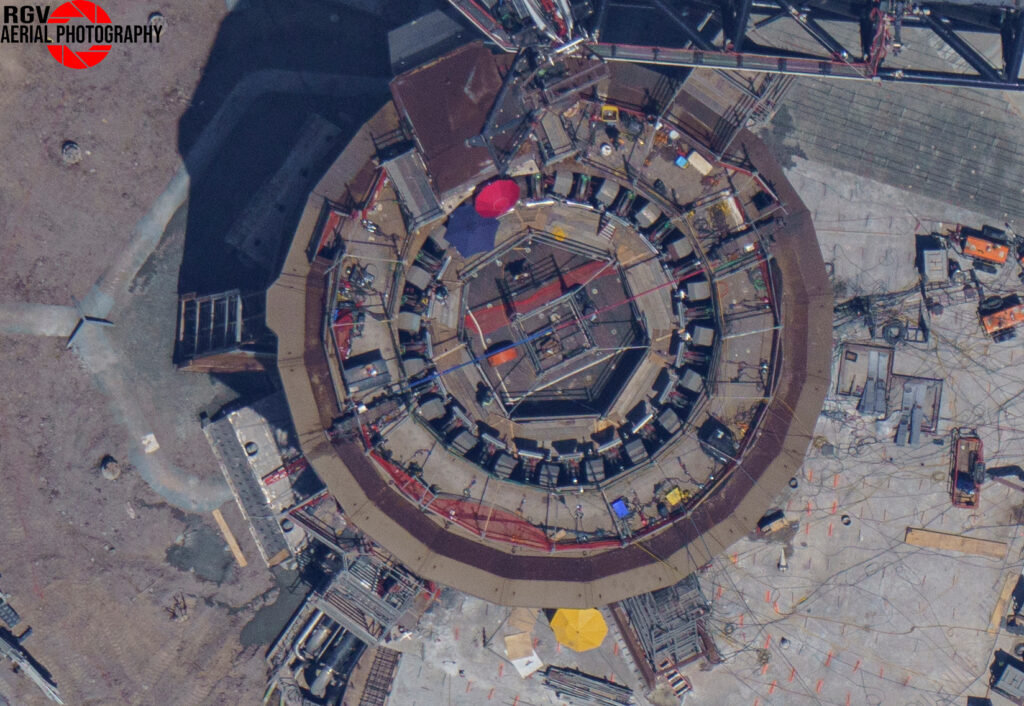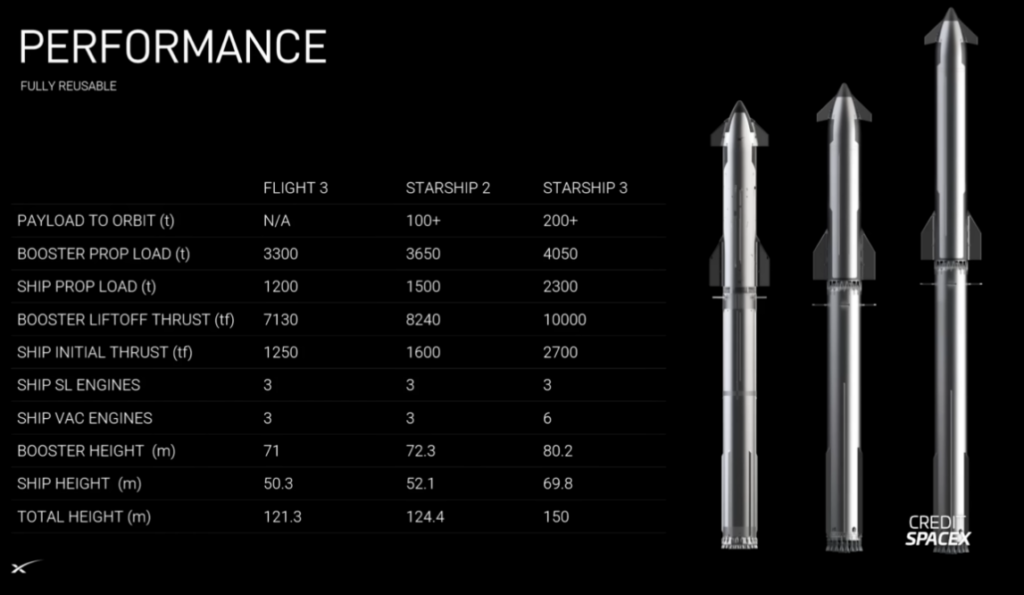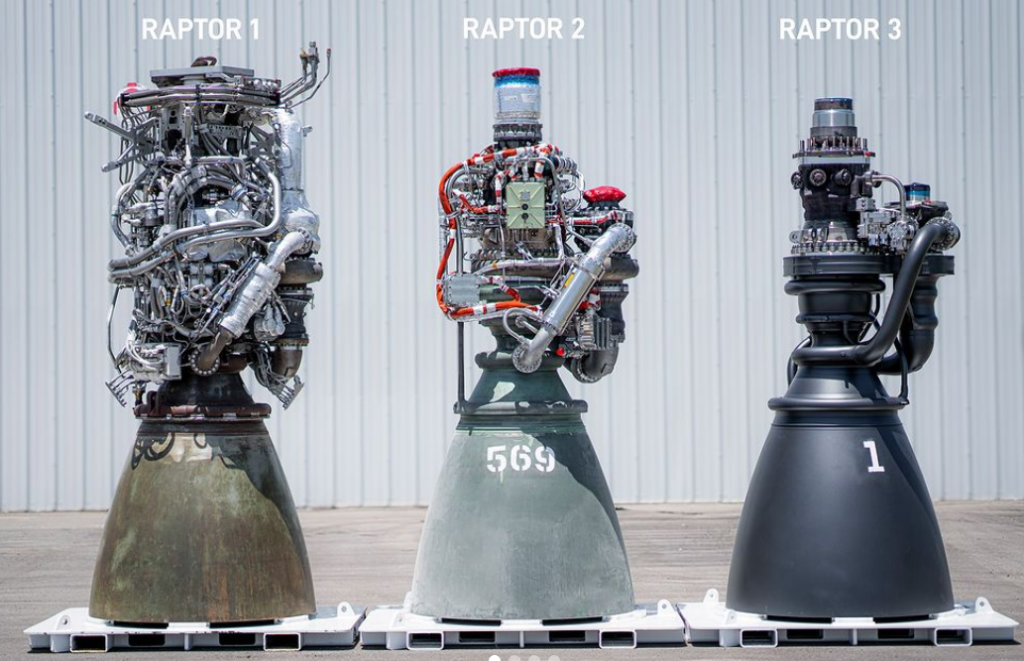SpaceX Starship progress
SpaceX Starship progress
Year
2018
- 00-12-2018 Starhopper. First static fire: 03-04-2019. Maiden flight: 25-07-2019.
- 00-12-2018 MK1.
2019
- 00-05-2019 MK2.
- 27-08-2019 Starhopper, 150 meter hop test.
- 1 minute flight.
- 00-09-2019 MK4.
- 00-10-2019 MK3/SN1 (SN Serial Number).
2020
- 00-03-2020 SN3.
- 00-04-2020 SN4. First static fire: 05-05-2020. No maiden flight.
- 00-04-2020 SN5. First static fire: 27-07-2020. Maiden flight: 04-08-2020.
- 00-05-2020 SN6. First static fire: 23-08-2020. Maiden flight: 03-09-2020.
- 00-05-2020 SN7. Not seen.
- 00-07-2020 SN8. First static fire: 20-10-2020. Maiden flight: 09-12-2020.
- 04-08-2020 SN5, 150 meter hop test.
- 00-08-2020 SN9. First static fire: 06-01-2021. Maiden flight: 02-02-2021.
- 03-09-2020 SN6, 150 meter hop test.
- 00-09-2020 SN10. First static fire: 23-02-2021. Maiden flight: 03-03-2021.
- 00-09-2020 SN11. First static fire: 22-03-2021. Maiden flight: 30-03-2021.
- 00-11-2020 SN15. First static fire: 26-04-2021. Maiden flight: 05-05-2021.
- 09-12-2020 SN8, high-altitude flight test, landing attempt No. 1.
- 1 st engine cutoff.
- 2nd engine cutoff.
- Liqued oxygen release (dump).
- 3rd engine cutoff.
- Vehicle reorientation.
- Flip maneuver.
- Landing burn.
- Landing failure No. 1.
2021
- SN16/Starship.
- 02-02-2021 SN9, high-altitude flight test, landing attempt No. 2.
- Landing failure No. 2.
- SN17.
- SN18.
- 03-03-2021 SN10, high-altitude flight test, landing attempt No. 3.
- Exploded eight minutes later on the landing pad after touching down harder than expected.
- Landing failure No. 3.
- 30-03-2021 SN11, high-altitude flight test, landing attempt No. 4.
- Rapid unscheduled disassembly occured after losing telemetry data with Starship.
- Failure No. 4.
- SN17.
- SN19.
- 05-05-2021 SN15, high-altitude flight test, landing attempt No. 5.
- 6 minutes flight.
- Soft landing achieved.
- SN20/Starship. First static fire: 21-10-2021.
- SN21.
- SN22.
- SN23.
- 00-11-2021 SN24. First static fire: 09-08-2022. Maiden flight: Not yet.
2022
- 00-03-2022 S25. First static fire: Not yet. Maiden flight: Not yet.
- 00-05-2022 S26. First static fire: Not yet. Maiden flight: Not yet.
- 00-06-2022 S27. First static fire: Not yet. Maiden flight: Not yet.
- 00-07-2022 S28. First static fire: Not yet. Maiden flight: Not yet.
- 11-07-2022 High-energy test event.
- 25-08-2022 First lift of a booster on the OLM with Mechazilla grabbing arms (chopsticks). Mechazilla is about ensuring a soft landing to protect the invaluable technology within the booster.
- 00-10-2022 De-stacking.
- 11-10-2022 First time full stack of
- SpaceX Super Heavy Booster (SH, Booster 7, B7)
- SpaceX Starship HLS (Starship 24, Ship 24, S24)
- 13-10-2022 First full stack test. Poor results.
- 16-10-2022 De-stacking.
- 20-10-2022 Re-stacking.
- 24-10-2022 Stacked vehicle: Conduct LOX and LCH4 single species prop system test.
- 00-11-2022 B7: Complete 1-engine static fire test.
- 00-11-2022 B7: Complete 3-engine static fire test.
- 00-11-2022 B7: Complete 7-engine static fire test.
- 28-11-2022 Fire suppression test.
- 29-11-20222 B7: Complete 11-engine static fire test.
- 00-12-2022 S24: Complete 2-engine static fire test.
- 00-12-2022 S24: Complete 6-engine static fire test.
- 00-12-2022 B7 and S24: Re-stacking.
- 00-12-2022 Additional single-species prop system testing.
- 00-12-2022 Additional de-stacked static fire tests.
- 31-12-2022 The production site produced 4 Super Heavys, 5 Starships and 200 Raptors.
2023
- 09-01-2023 Stacking B7 and S24. Lift onto OLM.
- 12-01-2023 Ground Support Equipment (GSE) Tank testing.
- 13-01-2023 Propelland Load Test.
- 18-01-2023 Propellant Load Test.
- 20-01-2023 B8 and S22: Dismantled.
- 20-01-2023 Hydraulic Pressure Unit (HPU) removed from B7. The battery still remains.
- 20-01-2023 Orbital Launch Mount (OLM) platform lowered from under the full stack.
- 23-01-2023 B7 and S24 First full-stack Wet Dress Rehearsal (WDR).
- Temporary Flight Restrictions (TFR) Brownsville (Boca Chica): 14,000 ft.
- Marine Safety Information Bulletin (MSIB).
- B7
- 800 MT CH4
- 2800 MT LOX
- S24
- 260 MT CH4
- 1000 MT LOX
- 25-01-2023 Examination of the WDR results.
- 29-01-2023 Status update
- Starship:
- S24 Preparing for OTF (Orbital Test Flight).
- S25 Awaiting tests.
- S26 Assembled, awaiting tests.
- S27 Preparing for large assembly.
- S28 – S31 Parts production.
- Super Heavy/Booster (SH/B)
- SH7 Preparing firing test with 33 engines.
- SH9 Engine installation, awaiting tests.
- SH10 Mass assembly.
- SH11, SH12, SH13, SH14 Parts production.
- Starship:
- 02-02-2023 De-stacking SH7 for static fire
- 09-02-2023 B7 Static fire. Target: All 33 Raptor engines of Booster 7 run simultaneously. Results: Team turned off one Raptor just before start and one Raptor stopped itself, so 31 Raptor engines fired overall. Still enough engines to reach orbit.
- Duration of this static fire test was seven seconds.
- At 50% thrust (7.9 million lbf of thrust (3,600 metric tons).
- Despite losing two Raptors, SpaceX still broke the all-time record for the number of rocket engines ignited simultaneously. That record was held by N1 rocket, which launched four times with 30 NK-15 engines in the late 1960s and early 1970s. None of its test flights were successful.
- Neither SpaceX nor CEO Elon Musk has confirmed it, reducing the odds that Super Heavy Booster 7 broke that historic thrust record. But it certainly could have. Each Raptor 2 engine can generate up to 230 tons (507,000 lbf) of thrust at sea level. Raptor is theoretically designed to throttle as low as 40%, or 92 tons (~200,000 lbf) of thrust. With 33 engines operating nominally at their minimum throttle setting, Super Heavy would have produced 3036 tons (~6.7M lbf) of thrust during today’s static fire – not a record.
- 19-02-2023 Crew-6 Dragon arrives at LC-39A ahead of flight.
- 20-02-2023 S26 on suborbital Pad A.
- 01-04-2023 SpaceX is opening a facility in Bastrop (TX, near Austin) that will be used to manufacture Starlink equipment.
- 01-04-2023 Work on isolating the Orbital Launch Mount (OLM) finished.
- 03-04-2023 Propellant loading test.
- 10-04-2023 Nine static fires in all for Starship.
- 14-04-2023 FAA License. The U.S. Federal Aviation Administration has issued a launch license to SpaceX for the Starship orbital flight test.
- 15-04-2023 The production site produced 5 Super Heavys, 8 Starships and x Raptors.
- 17-04-2023 A 150-minute test window will open 17-4-2023 at 7:00 a.m. local time (CDT).
- 17-04-2023 This will mark the first time that the Super Heavy booster and the second stage (also called Starship) fly together. Assuming lift-off is nominal, the plan is for stage separation to occur roughly three minutes into the mission, with the booster and second stage splashing down into the Gulf and the Pacific Ocean, respectively. SpaceX will not attempt to recover these components. On its website, SpaceX makes no promises for how the test will go, or even if it will complete milestones like Max Q (the point of maximum pressure on the vehicle) or Starship ignition. Instead, its likely that the company is looking to simply gather as much flight data as it can as the company continues to iterate the 394-foot-tall Starship system.
- 17-04-2023 First orbital flight of Starship. Scrubbed. At T minus 17 minutes an issue arises with loading the Super Heavy’s fuel. Exceeding a parameter of the pressure system. It is decided to proceed with fuel loading as a WDR to T minus 40 seconds. Flight Termination System (FTS) has not been armed. Scrub takes at least 48 hours (minimum recycle time). Probably a frozen pressure valve was the cause. Moisture in velve.
- 20-04-2023 SpaceX Starship I sequence of events (IFT-1). B7 and S24 Liftoff. First flight of Starship. Second launch attempt. Flight ended after 4 minutes.
- 01-05-2023 FAA faces lawsuit over SpaceX’s damage to local environment. The suit alleges that the FAA failed to adequately assess the environmental fallout from launches at SpaceX’s Starbase.
- 12-05-2023 Start water spray construction under Orbital Launch Mount (OLM).
- 13-05-2023 Successful static fire of the new Raptor 3 engine to 350 bar chamber pressure (5,100 psi) for 45 seconds, producing 269 tons of thrust. Raptor 3 reached 18% more thrust than a Raptor 2.
- 14-05-2023 SpaceX reduced the weight of the Raptor engine. Turnaround time should be about an hour. The cost per launch is currently USD 2 million.
- 19-05-2023 Steal plates placed under the Orbital Launch Mount (OLM) and tested.
- 03-06-2023 Spaceship’s second test flight will be made with S25 and B9.
- 04-06-2023 B10 in rocket garden, B11 in Mega bay and B12 construction started. Low bay demolished.
- 15-06-2023 Engine testing S25 aborted (spin prime).
- 22-06-2023 Flight-like chill and spin of the S25 Raptor engine pumps, stopping just before engine ignition. As a result of the test, cryogenic liquid oxygen formed a visible cloud beneath the ship. This checked out vital systems in advance if the upcoming static fire.
- 24-06-2023 SpaceX is changing the approach for separating the two stages of its Starship vehicle to increase payload performance before its next test flight. SpaceX recently decided to switch to a “Hot-staging” approach where the Starship upper stage will ignite its engines while still attached to the Super Heavy booster. Thereis a meaningful payload-to-orbit advantage with hot-staging that is conservatively about a 10% increase. Hot-staging, which has been used on Russian launch vehicles for decades, involves igniting the engines on one stage while still attached to its lower stage. Musk said that, for Starship, most of the 33 Raptor engines on the Super Heavy booster would be turned off, but a few still firing, when the engines on the Starship upper stage are ignited. Doing so, he said, avoids the loss of thrust during traditional stage separation, where the lower stage shuts down first. Musk said SpaceX is working on an extension to the top of the booster “that is almost all vents” to allow the exhaust from the upper stage to escape while still attached to the booster. SpaceX will also add shielding to the top of the booster to protect it from the exhaust. The Raptors on the new vehicles include changes to the hot gas manifold in the engine to reduce fuel leakage.
- 26-06-2023 B11 moved to Rocket Garden. Concrete pouring under the OLM has begun.
- 27-06-2023 S25 Static fire. All six Raptor engines for the first time:
- 15:02 Road closed
- 15:38 Pad clear
- 17:35 Soft venting
- 17:56 Cryo loading
- 19:01 Siren
- 19:04 Engine chill
- 19:27 S25 Static fire
- 21:45 Cars to pad
- 21:47 Road open
- 01-07-2023 Water sprays from below against the rocket engines to reduce acoustic vibrations and convert energy into steam. This is a different approach than NASA, where a large amount of water is dumped. Deluge system.
- 02-07-2023 Hot staging was also applied in Soyuz. The two stages must be separated by a kind of fence. Hot stageing prevents unnecessary loss of speed when transitioning from the first to the second stage. The challenge is to keep the first stage intact and to allow it to land independently after separation. This method would be 10% more efficient. Permission from the FAA is also required for this.
- 13-07-2023 Ship Quick Disconnect (SQD) test.
- 17-07-2023 Water cooled steel plate test.
- 19-07-2023 The ship test stand that was previously at the cryo station at Masseys has been moved to the build site.
- 21-07-2023 Boca Chica update:
- B9 roll-out on SPMT (Self Propelled Modular Transporter).
- B9 chopsticks released and opened, SQD arm swung back in. New FTS on B9.
- B10 returned to the Rocket Garden.
- S27 cut in half.
- S28 arrived at Massey´s.
- S30 nosecone stacked on payload section inside HB (High Bay). Now 2 of 6 sections tall.
- 22-07-2023 Plans to add 3 more Raptor Vac to the Ships (starting with S25, S28 or S30?).
- 22-07-2023 B9 Cryo testing:
- 07:30 Road closed (CDT)
- 08:35 Pad clear
- 08:47 OTF (Orbital Test Flight) venting
- 09:07 OLM venting
- 10:25 Cryo loading
- 14:00 Completed
- 28-07-2023 Full pressure test of deluge system.
- 31-07-2023 Hot-staging test assembly rolled to Massey’s.
- 04-08-2023 B9 Spin Prime Test (SPT). Spin prime engine test. During the spin up test, the fuel passes through the engine systems, but is not ignited in the gas generators. Instead of hot gases, the turbine spins cold gas supplied from the outside. It spins the turbine up to operating speeds, and the pumps pump fuel at norminal pressure. Roughly speaking, this is a spill test without ignition. Each engine has two turbopumps, one for the LOX and the CH4 side each. During a Spin Prime Test, either side alone or both toghether can be tested.
- 06-08-2023 B9 Static fire. SpaceX fired up Booster 9 for a static test of its liquid methane-fueled Raptor rocket engines. The test was advertised to last “just under five seconds” but appeared to be cut short at 2.74 seconds. Four of the 33 Raptor engines were reported to have shut down prematurely. It was the first engine test using a new water deluge system.
- 08:00:00 Road closed
- 08:00:00 Pad clear
- 01:08:00 Propellant load start
- 01:11:00 Frost visible bottom B9
- 01:33:00 Frost visible middle B9
- In T-hh:mm:ss:
- 00:02:51 LOX load completed (big vent), OP, Over pressure
- 00:00:22 Deluge system start-up sequence started
- 00:00:07 Deluge system at max power
- 00:00:00 Static fire (short, 3 seconds)
- 09-08-2023 2nd tracking dish dismantled.
- 10-08-2023 New deluge tank arrived at the launch site.
- 12-08-2023 RBQD (Raptor Boost Quick Disconnect) test
- 15-05-2023 3th and final deluge tank installed.
- 16-08-2023 RQD (Raptor Quick Disconnect) test purges on the OLM. 4 RQD’s.
- 16-08-2023 Ship 29 and Ship 30 construction continues.
- 17-08-2023 Hot staging ring is being installed on Booster 9.
- 21-09-2023 Booster 10 moved back to mega bay 1 and placed on engine install stand.
- 08-09-2023 FAA Closes SpaceX Starship Mishap Investigation.
- 21-09-2023 SpaceX completed and documented the 57 items needed for the Integrated Flight Test-2 (IFT-2). B9/S25
- 21-09-2023 New 2 point ship lifting jig moved to the HB.
- 30-09-2023 Ship 25 stacked on Booster 9.
- 05-10-2023 Ship 25 destacked from Booster 9.
- 09-10-2023 Hot stage ring removed.
- 09-10-2023 Ship 26 completed tanking test:
- 08:25 Road closed
- 09:43 Pad clear
- 12:21 SOTF active (Tank Farm venting started)
- 12:34 Cryo loading
- 14:00 Detanking
- 15:37 Road open
- 22-10-2023 B9 and S25 First full-stack Wet Dress Rehearsal (WDR) (including FireX and Water System Test)
- 08:08 Road closed
- 08:24 Pad clear
- 10:37 FireX. System used to push away gas bubbles below the OLM. Fire suppression system.
- 11:30 Farm venting
- 01:02 Ship venting
- 13:33 Booster load
- 13:59 Ship load
- 15:23 FireX
- 15:38 Detanking
- 18-11-2023 SpaceX Starship II sequence of events (IFT-2)
- 13-12-2023 Sub-orbital test stand A demolished.
- 14-12-2023 S28 moved to launch pad.
- 14-12-2023 S28 placed on test stand B.
- 16-12-2023 S28 Spin Prime Test (SPT).
- 20-12-2023 S28 Static fire. 6 engines, full-duration.
- 21-12-2023 B10 Static fire aborted.
- 23-12-2023 SpaceX sign installed over gate D1 at KSC.
- 24-12-2023 Starship HLS sub-scale mockup elevator has been tested by NASA.
- 27-12-2023 During return to Port Canaveral booster B1058 toppled over and broke in half. Made 19 flights. Lost.
- 28-12-2023 Falcon Heavy launch of X-37B Space plane.
- 30-12-2023 S28 Static fire. 1 engine. And 90 minutes later
- 30-12-2023 B10 Static fire.
- 31-12-2023 B10 removed from OLM, B12 and S30 moved to Massey. S29 moved to MB2 (Mega Bay 2).
2024
- 03-01-2024 S30 Cryo pressure test (one).
- 06-01-2024 S30 Cryo pressure test (two).
- 16-01-2024 In IFT-2 there was LOX left in de tanks because there was no payload weight. Venting this LOX might have caused the RUD.
- 16-01-2024 Building a second Starship tower in Texas. Enables SpaceX to launch from one tower while upgrading the other.
- 16-01-2024 Argon hall-effect thrusters: SpaceX developed a new thruster that used argon as propellant for their Starlink V2 mini. The new thruster had 2.4 times the thrust and 1.5 times the specific impulse as SpaceX’s previous thruster that used krypton. Argon is approximately 100 times less expensive than Krypton and 1000 times less expensive than Xenon.
- 16-01-2024 RRR is Rapidly Reusable Rocket.
- 16-02-2024 WDR aborted.
- 03-03-2024 WDR B10 and S28.
- 12-03-2024 Plans to create a rotating section in a next Starship to provide astronauts with some gravity.
- 14-03-2024 SpaceX Starship III sequence of events (IFT-3)
- 17-03-2024 Working om the hexagonal heat shield tiles. Made of sintered silica fibre tiles with a Borosilicate RCG surface layer. 18.000 bricks. Tiles and pins. S29 upgrade nose cone tiles. Smaller tiles.
- 05-04-2024 S29 has left the high bay and was parked outside.
- 07-04-2024 New Raptor 4 announced (aiming 303 tF, trust Force). Less than a year after testing Raptor 3 (280 tF).
- Raptor 1 2000 kg
- Raptor 2 1600 kg
- Raptor 3 280tF
- Raptor 4 1500 kg, 303 tF is a TWR 202 (Trust to Weight Ratio)
- 07-04-2024 B11 moved back to Mega Bay 2.
- 09-04-2024 B11 and S29 at the production site.
- 09-04-2024 S29 tiles replaced.
- 09-04-2024 Launch site preparations continue.
- 13-04-2024 Replacement swing actuator installed on the left chopstick.
- 15-04-2024 New versions announced
- Booster 2 +2 meters
- Starship 2+3 meters
- Booster 3+9 meters
- Starship 3+19 meters, from 6 to 9 Raptors
- Starship Moon: The Starship that will land on the moon has a variant of the Crew Dragon in the nose cone for the return flight.
- Starship is now 40/50 tons and will be 200 tons.
- 16-04-2024 B11 and S29 still at the build site.
- 18-04-2024 Six Starship launches a year expected.
- 26-04-2024 B13 cryo tested at Massey’s Structural Test Site.
- 26-04-2024 Ultra-fast actuation testing chopsticks.
- 26-04-2024 Booster catch attempt is likely in 2024 (EM).
- 02-05-2024 S30 to launch site Suborbital Pad B.
- 30-04-2024 First time astronauts in pressurized spacesuits interacted with a test version of SpaceX HLS hardware.
- 02-05-2024 Ground support equipment test.
- 07-05-2024 S30 Cryo pressure test (three).
- 07-05-2024 S30 Static Fire (SFS) aborted.
- 08-05-2024 S30 Static Fire (SFS).
- 13-05-2024 Marine safety information bulletin issued for 16-05-2024.
- 13-05-2024 B11 lifted to OLM.
- 13-05-2024 S29 moved to launch complex.
- 13-05-2024 S30 to production site.
- 13-05-2024 S31 fire seen at unusual place during testing.
- 20-05-2024 WDR B11 and S29. LOX and Methane (CH4).
- 20-05-2024 FAA Pending (investigation IFT-3).
- 21-05-2024 Launch rehearsal IFT-4 complete. IFT-4 expected in about 2 weeks (approx. 05-06-2024).
- 27-05-2024 WDR B11 and S29.
- 01-06-2024 FTS installed for IFT-4.
- 03-06-2024 Starship tower components staged at the wharf turn basin at NASA Kennedy Space Center (KSC).
- 03-06-2024 S26 completed a static fire at Boca Chica.
- 03-06-2024 IFT-4 pending regulatory approval.
- 05-06-2024 Approval issued.
- 06-06-2024 SpaceX Starship IV sequence of events (IFT-4)
- 09-06-2024 Astronauts test SpaceX Starship hardware and spacesuits for Artemis III.
- 11-06-2024 S26 moved to the rocket garden. Work continues on the OLM and pad B. Tile work underway on S30.
- 12-06-2024 EM: Aiming for flight 5 and Booster catch in 07-2024.
- 12-06-2024 EM: Targeting first launch from NASA Kennedy Space Center (KSC) in the middle of 2025.
- 16-06-2024 Boca Chica (BC): Work continues on Pad A, Pad B taking shape, Ship 30 tiles being replaced.
17-06-2020 Boca Chica (BC): Third and fourth base columns of the second tower have been raised vertical. - 09-07-2023 B12 Upgrade:
New flight termination system box designed to enable a quick destruction of the rocket in case an anomaly happens.
Four Starlink antenna fittings present.
New “Remove before flight” covers for the Raptor boost quick disconnects (QDC).
- 10-07-2024 B12 Partial Cryo pressure tests (one).
- 10-07-2024 SpaceX rivals challenge Starship launch license in Florida over environmental, safety concerns. NASA Kennedy Space Center (KSC)
- 11-07-2024 B12 Partial Cryo pressure tests (two).
- 12-07-2024 B12 Spin prime test.
- 13-07-2024 FAA: Will hold public meetings on a proposal by SpaceX to increase the number of launches and landings in Boca Chica.
- 15-07-2023 B12 Static Fire (SFB, 33 engines).
- 29-07-2024 SpaceX is in talks with U.S. and Australian officials to land and recover one of its Starship rockets off Australia’s coast, a possible first step toward a bigger presence for SpaceX.
- 22-09-2024 Remains of B11 recovered after IFT-4.
- 23-09-2024 B12 and S30 stack performed a prop test load (IFT-5).
- 24-09-2024 Ship Quick Disconnect (SQD) arm parts arrive at Starbase.
- 13-10-2024 SpaceX Starship V sequence of events (IFT-5)
- 19-11-2024 SpaceX Starship VI (IFT-6)
SpaceX skips giant rocket catch on 6th test flight. Flight data didn’t support an attempt. Super Heavy ended up coming down for a controlled splashdown in the Gulf of Mexico instead, hitting the waves seven minutes after liftoff.
SpaceX also wanted to put Starship’s upper stage through its paces.
The launch sent Ship on the same semi-orbital trajectory that it took on Flight 5, targeting a splashdown in the Indian Ocean off the northwestern coast of Australia about 65 minutes after liftoff. But Ship also achieved some new milestones along the way this time.
For example, Flight 6 carried the first-ever Starship payload — a plush banana onboard Ship, which served as a zero-gravity indicator. (It was not deployed into space.) In addition, Ship briefly re-lit one of its six Raptor engines about 38 minutes into the flight.
This burn helped show that Ship can perform the maneuvers needed to come back to Earth safely during orbital missions. Indeed, Ship is designed to be fully and rapidly reusable, just like Super Heavy; SpaceX eventually intends to catch it with the chopstick arms as well, and will likely try to do so on a test flight in the near future.
Flight 6 also tested modifications to Ship’s heat shield, which protects the vehicle during reentry to Earth’s atmosphere.
“The flight test will assess new secondary thermal protection materials and will have entire sections of heat shield tiles removed on either side of the ship in locations being studied for catch-enabling hardware on future vehicles,” SpaceX wrote in a mission description. “The ship also will intentionally fly at a higher angle of attack in the final phase of descent, purposefully stressing the limits of flap control to gain data on future landing profiles.”
SpaceX also shifted the launch time for Flight 6, to allow for better observation of Ship’s reentry and splashdown. Flight 5 (and all four of its predecessors) lifted off from Texas in the morning, and Ship came down in darkness on the other side of the world.
The fact that it survived all the way through while flying a lesser-gen heat shield is just absolutely incredible.”
- 05-12-2024 SpaceX Starship VI (IFT-6) flight data analysis:
- Booster: No attempt to catch the booster because there were computer-communication problems between the booster and the tower.
- Booster: Explosion of the booster followed after landing in the ocean (not shown).
- Ship: During launch and re-entry, ripples are visible in the steel surface in places where no tiles have been applied.
- Ship: During landing, it is visible that a hatch is released from the back of the vessel. A hole becomes visible.
2025
- 16-01-2025 SpaceX Starship VII (IFT-7)
- S33 and B14.
- S33 Mark II version (block upgrades)
- Larger tanks
- SpaceX to attempt first payload deployment, engine reuse.
- 16-01-2025 Sequence of events IFT-7
00:00:00 Starship liftoff
00:02:40 Starship ignition and stage separation (hotstaging)
00:02:46 Boostback burn start
00:03:29 Boostback burn shutdown
00:03:31 Hotstage jettison
00:06:54 Booster catch successful
00:07:39 Ship engines begin to fail. Telemetry freeze: speed 21.317 km/h, altitude 146 km, CH4 dropping fast.
00:08:26 Ship explosion
00:00:00 Ship debris in Caribbean
- 16-01-2025 SpaceX Starship VII (IFT-7)
- 17-01-202 Reactions IFT-7
SpaceX statement : Ship oxygen/fuel leak in the cavity above the ship engine firewall that was large enough to build pressure in excess to the vent capacity.
FAA: Starship mishap investigation (debris out of corridor)
- 17-01-202 Reactions IFT-7
- 00-00-2025 SpaceX Starship VIII (IFT-8) Expected
- 00-00-0000 SpaceX Starship all missions
Footnote
- Sources: Aerospace dashboard, SpaceX, funkystuff.org
- Outgoing: NASA
- Keywords: Spacex Starship progress, test, testing

